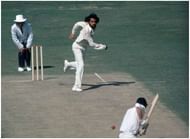Unbeknownst to many, there is an unofficial divide at the root of Indian cricket. Even as the much-feted batsmen perch proudly atop the upper echelons of the illustrious dynasty, the derided bowlers usually do not get the same attention despite continuing to render yeoman service to their country.
Bhagwath Subramanya Chandrasekhar, who turns 72 next week, is one such classical icon whose mesmerising exploits with the ball have not quite been accorded the corresponding mythical status of a Sunil Gavaskar epic or a Sachin Tendulkar masterclass.
Affectionately called ‘Chandra’ within the cricket community, he was a pivotal part of the legendary spin quartet also comprising of Bishan Singh Bedi, Erapalli Prasanna and Srinivas Venkataraghavan. Unlike any of his compatriots, the admirable leg-spinner had to overcome a physical deformity before establishing himself as arguably India’s most impactful player during its developmental stages.
At the tender age of six, the Mysore-born cricketer was afflicted by the assiduous grips of polio. The attack caused a permanent weakening to his right arm. Undeterred by the travails of childhood, he shaped his game around the withered hand and went on to wreak havoc on the field. Converting the impediment into a position of advantage, Chandra became a role-model for plenty of aspiring spinners including a certain Anil Kumble.
A game of glorious uncertainties
During those days, very few cricketers encapsulated the oft-repeated adage of cricket being a game of glorious uncertainties. With his languid run-up and inimitable action, Chandra ensured that he would firmly entrench himself in the enigmatic club.
Operating at a pace, similar to those of the then new-ball bowlers for India, he coupled devilish leg-breaks with searing top-spinners to leave opposition batsmen in a state of confinement. Add the effervescence of his serrated googly, the maverick had a complete armoury at his disposal. Not many could claim to have a stranglehold over the intimidating Sir Vivian Richards whom he famously referred to as his ‘bunny’.
While he could entrap even accomplished gun-slingers in his wiles, his unpredictability also came at a cost. On occasions when he did not quite get it right, Chandra had the tendency to go for runs aplenty. Even he himself admitted to not knowing which direction the ball was going to spin towards.
However, at the top of his game, he was the cornerstone of India’s most memorable away victories at a time when such rewards were rather sparse. Capable of extracting disconcerting bounce from all types of pitches, his free-spirited approach was a breath of fresh air to those disenchanted by the trappings of tradition.
Between his debut in January 1964 and his final appearance on July 1979, India won nine Test matches away from the familiarity of home conditions. In five of those games, Chandra picked up 42 wickets at an average of 17.14 including five five-wicket hauls. From The Oval to the Sydney Cricket Ground (SCG), he left an indelible imprint on numerous unchartered territories.
For self-respect and beyond
When India embarked on a tour of England in 1971, they did so with the knowledge of their abysmal record in the country. Until then, 19 Tests in the confines of those treacherous seam-friendly conditions had begotten 15 defeats and 4 stalemates.
After a couple of drawn encounters, attention shifted to The Oval for the traditional summer-ending Test. At the start of the fourth day, India were staring at a massive first-innings deficit. A rearguard effort from Syed Abid Ali and Venkataraghavan cut down England’s lead to 71. What followed was a scarcely believable spell.
In two-and-a-half hours of utter mayhem, Chandra tore through England’s batting lineup. Armed with a self-effacing grin, he produced a virtuoso performance to send the hosts plummeting to a symbolic total of 101. It was that kind of day – the pioneers of the game had been treated to a crash course on Test-class bowling.
Despite experiencing a stutter or two, India overhauled the measly fourth-innings target to record their maiden Test as well as series victory on English soil. Seldom did the sport stand as a means for transcendence. However, by conquering Ray Illingworth’s troops, the visitors had buried the vestiges of colonialism and emerged outwards as a nation brimming with credence and hope.
Extra Cover: Indian cricket’s watershed moment in 1971
According to Wisden, the triumph evoked ‘dancing in the streets’ as ‘revellers stopped and boarded buses to convey the news to commuters’ while children ‘garlanded wireless sets’ in their homes. 31 years later, Chandra’s monumental 6/38 was declared as the bowling performance of the century by an Indian.
The moment would go on to etch him as the genius who made things happen for a team searching for self-respect. Not a purveyor of statistics, he earned the veneration of his peers and had a lasting impact on those bestowed with the privilege of watching him in action.
“What is now proved was once only imagined”. Perhaps, William Blake’s musings from The Marriage of Heaven and Hell embodies the wrist spinner's wild genius. Refusing to lament, the eternal warrior did not just overcome physical odds but also had the gall to turn the weakness into a strength. Even as time changes and cricket evolves, Chandra’s legacy will remain undiminished.
Follow IPL Auction 2025 Live Updates, News & Biddings at Sportskeeda. Get the fastest updates on Mega-Auction and cricket news


